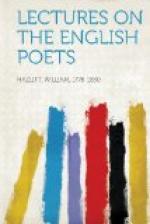The best descriptive poetry is not, after all, to be found in our descriptive poets. There are set descriptions of the flowers, for instance, in Thomson, Cowper, and others; but none equal to those in Milton’s Lycidas, and in the Winter’s Tale.
We have few good pastorals in the language. Our manners are not Arcadian; our climate is not an eternal spring; our age is not the age of gold. We have no pastoral-writers equal to Theocritus, nor any landscapes like those of Claude Lorraine. The best parts of Spenser’s Shepherd’s Calendar are two fables, Mother Hubberd’s Tale, and the Oak and the Briar; which last is as splendid a piece of oratory as any to be found in the records of the eloquence of the British senate! Browne, who came after Spenser, and Withers, have left some pleasing allegorical poems of this kind. Pope’s are as full of senseless finery and trite affectation, as if a peer of the realm were to sit for his picture with a crook and cocked hat on, smiling with an insipid air of no-meaning, between nature and fashion. Sir Philip Sidney’s Arcadia is a lasting monument of perverted power; where an image of extreme beauty, as that of “the shepherd boy piping as though he should never be old,” peeps out once in a hundred folio pages, amidst heaps of intricate sophistry and scholastic quaintness. It is not at all like Nicholas Poussin’s picture, in which he represents some shepherds wandering out in a morning of the spring, and coming to a tomb with this inscription—“I also was an Arcadian!” Perhaps the best pastoral




